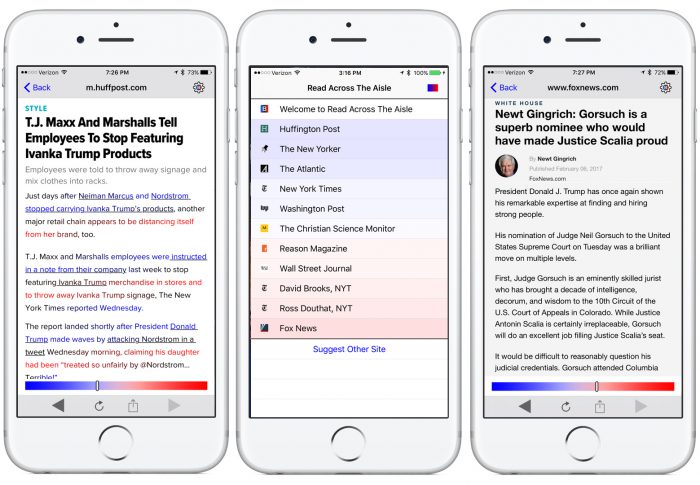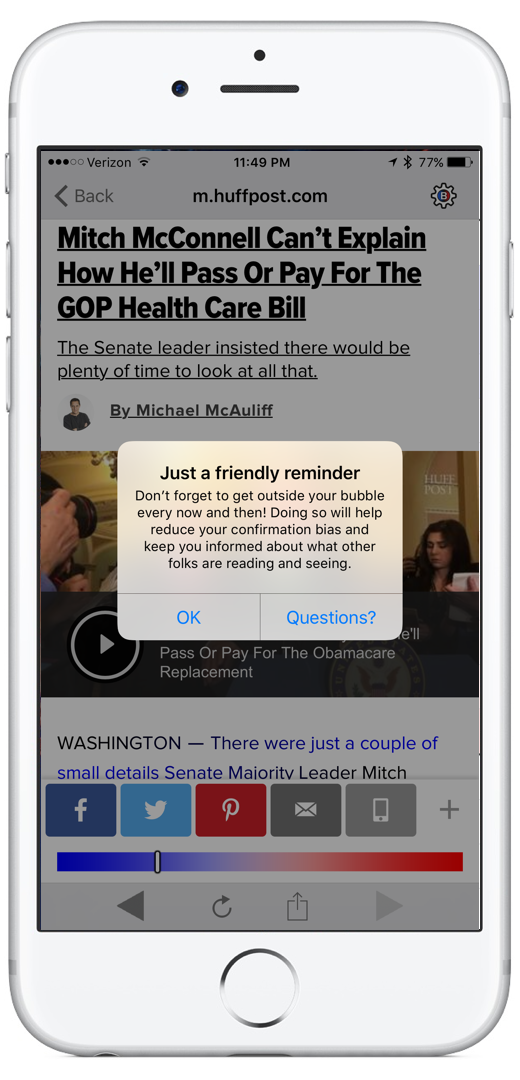
In their effort to help fix the filter bubble problem, developers of news app Read Across the Aisle took inspiration from an unlikely source: exercise trackers.
Designed to help people diversify their news consumption habits, Read Across the Aisle tracks how often users read stories from roughly 20 news sources across the ideological spectrum, with The Huffington Post at the far left of the spectrum, Fox News at the far right, and others like The New Yorker, NPR, and The Christian Science Monitor in between. A slider bar at the bottom of the screen moves from left to right based on how much time users spend reading news from certain sources, and how ideologically extreme the app deems those sources to be.
The app is designed to help users escape their news consumption bubbles. When the user’s reading habits skew too far to either side, the app triggers a notification recommending that they switch things up. It’s meant to do for news consumption what devices like the Fitbit and LumoLift do for exercise and posture, respectively: track users’ activity, and when they fall short of their goals, nudge them to do better.
“This is an app for people who say, ‘I have a problem. My media diet is not balanced. I eat too much from one food group and not another,'” said Nick Lum, the app’s founder and the creator of BeeLine Reader, a browser extension and app that uses color gradients to make articles easier to read (he’s also a “recovering lawyer”). “It’s for people who recognize that problem and want to fix it.”
Read Across the Aisle was funded via Kickstarter, where 127 backers gave a total of $5,376 (as of writing).
Where does Read Across the Aisle get its ideology ratings, which some people are sure to disagree with? One is a 2014 report from Pew Research that categorized media outlets based on how much they were trusted by partisan audiences (Fox News, for example, is highly trusted by conservatives, but not by liberals). Read Across the Aisle’s developers also consulted the app’s early users and Kickstarter backers, who helped crowdsource the ratings by placing the news sources on an ideological spectrum.“These sources were pretty consistent with each other. There’s not a whole heck of a lot of disagreement about where most of the outlets stand in the aggregate,” Lum said.
One clear limitation to the app (which is iOS only): Its list of news sources is limited to just 20 so far. The app’s ideology tracking also only works within the app itself, which is a significant shortcoming when most people only use a handful of apps. Read Across the Aisle’s developers are working on a browser extension that will extend the functionally to desktop reading.
Lum’s inspiration for his app is likely familiar to anyone who spent time on Facebook or Twitter in the past year. Lum said that friends on both sides of the ideological spectrum, trapped in their own bubbles, rarely questioned their own political beliefs and railed against those of others. Often, he said, their arguments betrayed a lack of understanding about alternative views. It’s in many ways the digital equivalent of the “great sorting,” the idea coined by Bill Bishop that more people are clustering into like-minded groups, creating a less connected, more polarized society. The filter bubble problem, despite being in part a product of more efficient algorithmic distribution of news, has so far evaded a technical solution. Attempts at fixing it in small ways abound. The Guardian, for example, created Burst Your Bubble, a regular column that lists conservative-learning articles meant to expand the horizons of its left-leaning readership. Red Feed, Blue Feed, a product from The Wall Street Journal, places liberal Facebook and conservative Facebook side-by-side. And Escape Your Bubble, a plug-in for Chrome, attempts to bridge divides by inserting positive articles about groups users say they want to be more accepting of. Indivisible is aiming for similar ends with public radio listeners.Lum argued that the filter bubble problem needs to be fixed before people are able to have the right kinds of conversations about bigger topics like healthcare and education. “We can’t fix those things if we aren’t listening to what the other side is saying,” he said. “It’s a fundamental problem in and of itself.” The goal isn’t necessarily to push people to read extreme partisan news sources, he said, but rather to help train the app’s users to see both sides of a debate by reading on both sides.
 Lum said he’s been in talks with a handful of news organizations interesting in partnering with the app. None of the plans are far along, but the potential partners might be attracted by Read Across the Aisle’s users, who by using the app have already expressed a willingness to hear opinions on multiple sides of certain issues.
Lum said he’s been in talks with a handful of news organizations interesting in partnering with the app. None of the plans are far along, but the potential partners might be attracted by Read Across the Aisle’s users, who by using the app have already expressed a willingness to hear opinions on multiple sides of certain issues.
“We’d love to have a relationship with, for example, The Wall Street Journal, where people we’ve identified as ideologically liberal can read their opinion section in our app without hitting the paywall,” Lum said. “I would think that the people who run the opinion section there would really want more liberals to read that work and spread those ideas.”
Read Across the Aisle also wants to expand its efforts across the world. Filter bubble issues are not limited to the United States, which is why people from the U.K., Canada, Australia, and South Korea have already contacted Lum asking him to develop versions of the app for their countries’ news sources. Future plans, in addition to the Chrome plug-in, include more in-depth historical data so users can see how their consumption habits have changed over time.
While Read Across the Aisle’s developers don’t expect the app to reverse the filter bubble problem, the hope is that it will have some effects on the margins. “If we can take the people who are using the app, expose them to new ideas, and turn them into lighthouses within their own social media bubbles,” said Lum, “we’ll start to break down walls as people understand the other side, even if they disagree with the actual policy goals.”